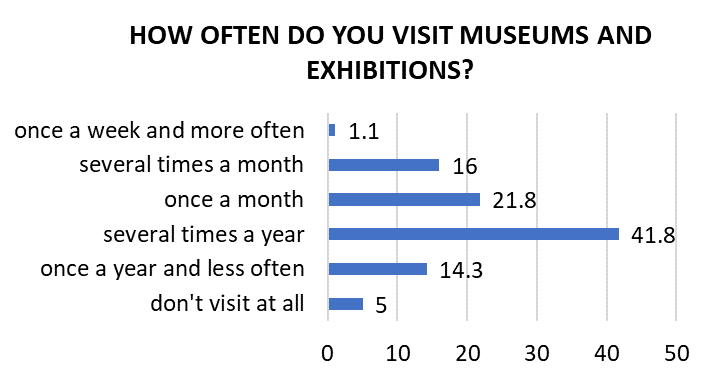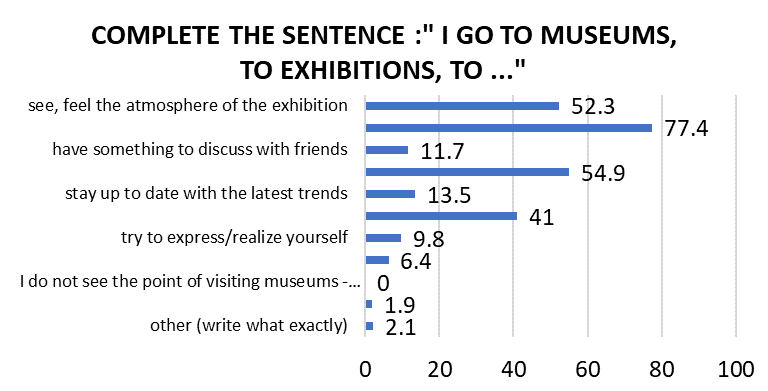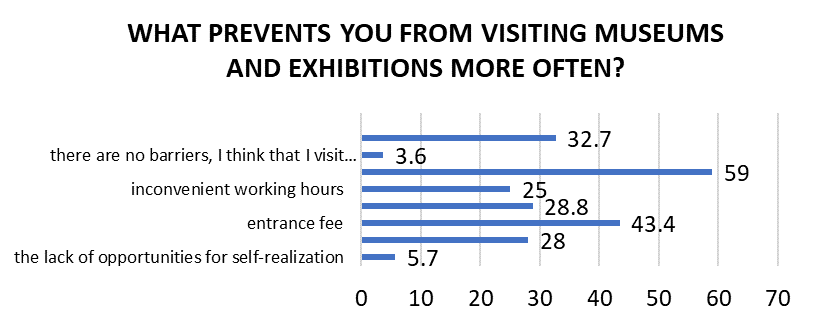Abstract
The article is devoted to the issue of changing processes in the museum communication under the active penetration of Internet technology in different spheres. Modern museums are changing their position in the society, moving from the format of traditional organizations engaged in the preservation and transfer of cultural values to organizations offering audiences different types of activities, including self-realization ones. The aim of the study is to identify relevant communication channels and methods to engage the audience in the consumption of cultural museum products. To achieve this goal, different methods are applied: theoretical research (analysis of theoretical sources, analysis of social information) and empirical research (survey). The analysis of theoretical sources revealed trends affecting museum activities on a global scale: the need to use marketing communications to promote museum activities, the use of digital technologies directly in the museum space, the organization of events co-creation for more active audience involvement, the use of personalized communication with visitors. The survey was conducted in 2018, the sample size was 280 respondents. The article presents the main results of the empirical study reflecting changes in the lifestyle of young Russian citizens, changes in the structure of their leisure time and in the used communication channels. The reasons of visiting and non-visiting museums by young people are analyzed. Based on the analysis of theoretical sources and results of the empirical research, the authors formulated recommendations for the development and adjustment of communication activities of museums taking into account needs of different audience segments.
Keywords: Museum communicationco-creationonline channelsconsumer behaviourdigital technology
Introduction
Communication in the modern society is becoming more and more mediated. Deep penetration of Internet technology into all spheres and aspects of human activity is an integral part of everyday life. Shopping online, using messengers to communicate and exchange information, distance learning using online technologies have become realities of our modern life. Digital technologies actively penetrate into the spiritual sphere, in particular, in the museum space. Modern museums are gradually moving away from the single-format concept, which is characterized by the implementation of one predominant activity (as a rule, this activity type is associated with the preservation of cultural values). Museums are becoming multi-format cultural organizations, they implement different activities (educational, scientific, exhibition, interactive, leisure and others). Modern museums face the problem of involving visitors, in particular, representatives of the younger generation. This problem is successfully solved abroad through the development and application of various methods and tools of communication with the consumer. Russian museums are on the way to solve this problem. To determine the most relevant communication ways with the museum visitors, we need to know their needs, lifestyle features of potential consumers of cultural products.
The main strategies of museum work with target audiences are:
universal positioning of the museum reflecting its main activity type with the expectation of attracting a motivated audience capable for perceiving complex cultural patterns;
segmentation of target audiences and development of a communication plan to work with each segment separately.
Accordingly, it is necessary to find out which communication channels are preferred from the consumers’ point of view, as well as how representatives of a certain segment spend their free time and how visiting museums can be integrated into the leisure structure of a particular segment of the audience.
Problem Statement
The problem of position changing and promotion of modern museums is actively covered in the works of foreign authors. The scientific view on the modern museum as a special phenomenon that is associated with the economy of impressions is presented in the works by ( Falk & Dierking, 2013; Popescu, 2019). The essence of this concept is that for certain segments of the audience, the goal in communication processes is shifted from obtaining knowledge and information to receiving and sharing impressions. Mclean ( 2012) believes that communication processes in museums should combine tools of culture marketing, service marketing and non-profit marketing.
Black ( 2012) distinguishes a special type of communication – museum communication, which aims to establish a connection between the museum, the museum exposition and the target groups. The target groups are not only potential and real visitors, but also representatives of influence groups (parents, teachers), representatives of state authorities, sponsors and many others.
Jaakkola and Alexander ( 2014) emphasize the need to apply co-creation format events for active consumer engagement. These events contribute to the interest formation in visiting museums, provide an opportunity to express themselves, to be engaged in the creation of a creative product.
A number of authors argue that it is necessary to carry out active targeted marketing communication aimed at the audience in order to activate the reaction of the audience and draw attention to the activities of cultural institutions ( Harmeling, Mofflett, Arnold, & Carlson, 2017; Hollebeek, 2013).
Other researchers focus on the need to introduce the latest digital technologies in museum activities: to use AR and VR technologies ( Nechita & Rezeanu, 2019); to make the museum space more interactive ( Valtýsson & Holdgaard, 2019). These technologies are preferred from the point of view of the youth audience, allow not only to passively perceive the museum exhibits, but also to interact with them.
Simon ( 2010) develops the concept of a participatory museum, that is, a museum in which a representative of the target group can manifest and realize himself. For the self-realization on the museum ground, it is not necessary to be a creator, an artist. Within the framework of the participatory concept, we are talking about the gradual blurring of boundaries between visitors and the museum space, which allows the audience to be involved, not to be afraid to experiment, to experience new social and cultural practices at the museum grounds. This idea can also be traced in the works of other authors ( Allison, 2019; Eid, 2019).
Research Questions
The following research questions were raised in this study:
what is the structure of leisure time for young Russian citizens?
what channels and methods of communication are preferable by representatives of the younger generation?
what are the reasons for young people visiting or not visiting museums?
how can the museum communication processes with target groups be adjusted?
Purpose of the Study
This research is aimed at identifying and analyzing relevant channels and methods of communication. It is necessary to understand how museums can engage the young audience in the consumption of cultural museum products.
Research Methods
The research was carried out using theoretical methods (analysis of theoretical sources, analysis of social information); empirical method (survey). The theoretical material was collected and structured: the authors determined key concepts of the implementation and promotion of the museum activities results. For the empirical phase of the study, a survey was conducted in 2018 to identify the attitude of young people (potential and real visitors of museums) to different forms of leisure time, communication channels, types of museum activities. The respondents were students of Moscow universities of the full-time education form (the type of the sample construction is random). The sample size is 280 respondents. The method of primary information processing is SPSS Statistics. The survey was conducted in the form of an online questionnaire. Among the respondents, 94% are undergraduate students, 5.2 % are undergraduate students and 0.8 % are specialty students, which generally corresponds to the percentage of students enrolled in Moscow universities at different educational levels. The survey results are valid and representative.
Findings
The results of the study showed that young people have different amounts of free time: a few hours of free time per month (6 % of respondents), a few hours of free time per week (29% of respondents), a few hours of free time every day (57% of respondents). The availability of a free time resource allows them to plan and spend their leisure time in a variety of ways. Among the leisure activities forms, young people indicated some forms that are directly or indirectly related to those activities that are carried out or can be carried out at museum grounds: communicate with friends and acquaintances offline (57% of respondents), communicate with friends and acquaintances online (57 % of respondents), go to the cinema, theaters, exhibitions, concerts, museums (52% of respondents), engagement in the artistic creativity (23% of respondents), attend additional educational events (16.4% of respondents).
Young people most often spend their free time with friends (85% of respondents) and relatives (56.6% of respondents). However, 41.5 % of respondents indicated that they spend their free time on their own, alone. These young people can be offered a variety of forms of leisure time spending in the museum space. One in three young people indicated that he spends his free time in the virtual space (28.3 %), which leads to the conclusion that cultural institutions should actively use the Internet communication to inform young people about upcoming events and activities, as well as for interactive interaction with potential and real consumers of cultural products.
Respondents visit museums with a different frequency (Fig.

Young people prefer to receive information via social networks (81.2 %), news and thematic sites on the Internet (58.3%), from Internet blogs and forums (29.3%). These communication channels should be more actively used by museums and other cultural institutions. When choosing a particular museum to visit, young people make this decision entirely on their own (33.8 %), listen to the opinion of their friends (27.2%), listen to the advice of parents and their closest relatives (18.8%).
Among the main reasons why young people visit museum, there are the following ones: broaden the mind, get new information (77.4 %), have a good time (54.9 %), see, feel the exhibition atmosphere (52.3 %) (Fig.

Young people gave reasons why they cannot visit museum more often. The main reasons are: limited free time (59 %) and the cost of entrance tickets (43.4 %) (Fig.

Conclusion
Summing up, on the basis of the theoretical analysis and results of empirical research, it is possible to offer some recommendations on the communication improvement between cultural institutions and their target groups:
more active use of online promotion channels: the creation of modern websites of museums, adapted for smartphones; the creation and actual filling of museum profiles of in the social media (VK, Facebook, Instagram etc.);
the development of a personalized communication with target groups representatives: email newsletter about museum events, mailing using messengers;
the improvement of different activities at the museum grounds, which are not directly related to the classical museum activities: educational activities, thematic clubs/communities etc.;
going beyond the museum space, that is, holding field events at the grounds of the target groups;
conducting activities with co-creation elements: co-creation in museums helps the audience, in particular, young people, to realize their need for the self-expression and self-realization;
the usage of interactive techniques in the design of museum exhibition, as well as in communication with visitors;
improving the pricing system in museums (a flexible pricing system for entrance tickets depending on the target segment, on the type of exposition; development of additional funding points: souvenir shops in museums, museum cafes, bookstores etc.);
the development of virtual museum spaces and virtual expositions to involve representatives of generation Z in the consumption of cultural products;
the involvement of reference personalities to disseminate information about museum activities, including the usage of viral effect (for example, bloggers).
References
- Allison, D. B. (2019). Engaging communities in museums: Sharing vision, creation and development. London, UK: Routledge. https://doi.org/10.4324/9781351037068
- Black, G. (2012). The engaging museum: Developing museums for visitor involvement. London, UK: Routledge. https://doi.org/10.4324/9780203559277
- Eid, H. (2019). Museum innovation and social entrepreneurship: A new model for a challenging era. London, UK: Routledge.
- Falk, J. H., & Dierking, L. D. (2013). The museum experience revisited. Walnut Creek, CA: Left Coast Press.
- Harmeling, C. M., Mofflett, J. W., Arnold, M. J., & Carlson, B. D. (2017). Toward a theory of customer engagement marketing. Journal of the Academy of Marketing Science, 45(3), 312-335. https://doi.org/10.1007/s11747-016-0509-2
- Hollebeek, L. D. (2013). The customer engagement/value interface: An exploratory investigation. Australasian Marketing Journal (AMJ). 21(1), 17-24. https://doi.org/10.1016/j.ausmj.2012.08.006
- Jaakkola, E., & Alexander, M. (2014). The role of customer engagement behavior in value co-creation: A service system perspective. Journal of Service Research, 17(3), 247-261. https://doi.org/10.1177/1094670514529187
- Mclean, F. (2012). Marketing the museum: Heritage: Care-preservation management. Abingdon, UK: Routledge.
- Nechita, F., & Rezeanu, C. -I. (2019). Augmenting museum communication services to create young audiences. Sustainability. 11(20), 5830. https://doi.org/10.3390/su11205830
- Popescu, C. C. (2019). Museum communication and entrepreneurial thinking. In C. Ignatescu (Ed.), Proceedings of the 12th LUMEN International Scientific Conference Rethinking Social Action. Core Values in Practice (pp.263-273). Iasi, Romania: LUMEN Proceedings. https://doi.org/doi.org/10.18662/lumproc.173
- Simon, N. (2010). The participatory museum. Santa Cruz: Museum 2.0.
- Valtýsson, B., & Holdgaard, N. (2019). The museum as a charged space: The duality of digital museum communication. In K. Drotner, V. Dziekan, R. Parry, & K. Schrøder (Eds.), The Routledge Handbook of Museums, Media and Communication (pp. 159-171). Abingdon: Routledge.
Copyright information

This work is licensed under a Creative Commons Attribution-NonCommercial-NoDerivatives 4.0 International License.
About this article
Publication Date
09 March 2020
Article Doi
eBook ISBN
978-1-80296-078-5
Publisher
European Publisher
Volume
79
Print ISBN (optional)
-
Edition Number
1st Edition
Pages
1-1576
Subjects
Business, business ethics, social responsibility, innovation, ethical issues, scientific developments, technological developments
Cite this article as:
Timokhovich*, A. N., & Filenko, S. S. (2020). Transformation Of Museum Communication: Challenges Of Time. In S. I. Ashmarina, & V. V. Mantulenko (Eds.), Global Challenges and Prospects of the Modern Economic Development, vol 79. European Proceedings of Social and Behavioural Sciences (pp. 1528-1533). European Publisher. https://doi.org/10.15405/epsbs.2020.03.219
